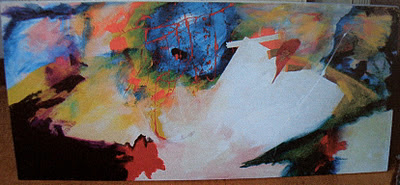One thing that needs to be included in my artist's statement is the question of movement. I have always felt that one of the chief weaknesses of traditional landscape painting -- and perhaps even of portrait painting -- is the fact that the figure and ground, the objects and the composition, often show no sense that the whole thing could move at any second. That is, the model could get up, the artist could turn her head or move the easel closer to the stand of trees, the light is changing ... The Cubists and the Futurists considered this point, but I believe it still needs to be resolved pictorially -- now.
If we look back at Constable's "Hadleigh Castle, the Mouth of the Thames: Morning After a Stormy Night" (see my post from November 10), we see the castle, the river, the rocks, the sky spread out before us. But -- how wonderful would it be if we could see all the things he could see as he was actually painting? The castle comes into greater focus, or the dog runs ahead ...
In her Lectures in America, in "Pictures," Gertrude Stein talks about movement: "Does an oil painting tend to go back into its frame because after all an oil painting belongs in its frame. Or does it not .... And if it does belong in its frame, must an oil painting be static." And she answers her own question -- no -- a painting need not be "static," and Stein goes to the example of a painting that seems --to her -- to move, Leonardo Da Vinci's 1499 work, "The Virgin, the Child, Saint Anne and John the Baptist." As it happens, we saw this painting at the National Gallery in London last year; it is a "sketch" for a more formal painting that was never completed, stretched across eight sheets of paper, but it is more beautiful than any "final" painting could be, I think:
Stein says that "in this picture there was an internal movement, not of the people or light or any of these things but inside .... In other words the picture did not live within the frame, in other words it did not belong within the frame .... [and since then] I have passionately hoped that some picture would remain out of its frame." And there is internal movement here; you can feel it, walking around in the gallery with it. This can be explained in part by the figures' sinewy curves, and by the background that dances just a bit beyond specificity. But really, as Stein goes on to say, a painting "must not completely only exist in its frame. It must have its own life. And yet it may not move nor imitate movement, not really, nor must it stay still. It must not only be in its frame but it must not, only, be in its frame." This is, in part, a discussion of the Modernist idea that a painting must be a thing in itself, and not representative of something outside of itself, but I also think this is about the life in a painting, the way a painting can feel like a very brief, exciting moment in a life.
So the artist, and the work of art, have this difficult task, to allow the art to move without moving. Can this be done now, without resorting to one-point perspective or any sort of illusion? Well, look at Helen Frankenthaler at work:
She is moving, the paint is moving, but it will all have to stop and, at some point, the painting will be in a show ... will it survive? I think so. Let's look at "Madame Matisse," from 1983:
Matisse had painted his wife with an enormous hat and a green stripe along her nose, a painting bought by Leo and Gertrude Stein, actually, and this painting takes that stripe and makes it move.
Part of what I am still working on, both in my statement and in this new series, is the idea that paintings should encourage the viewer to see ... to see just as if you were in the same landscape as the painting, and see the colors and the shapes as you would if you were walking by. Sometimes this will lead to the shapes seeming to be a blur, or to seem as if they were shrinking or growing; other times it will lead to one thing seeming specific, because it is what the painter chose to look at and to paint. We turn our heads, we focus in on objects, as we walk ... anywhere. Here is an early example of my landscape-as-movement idea, a 2 x 4' painting called "Landscape as Drama":




No comments:
Post a Comment